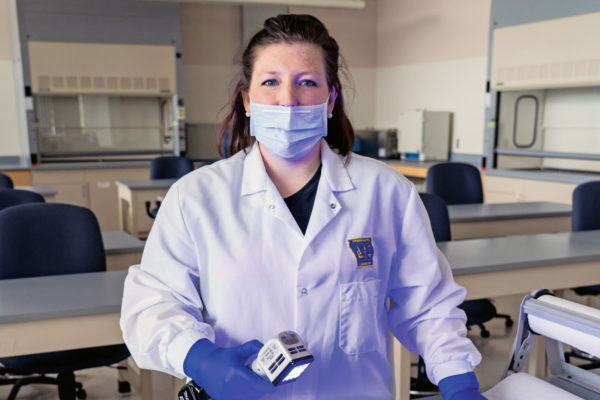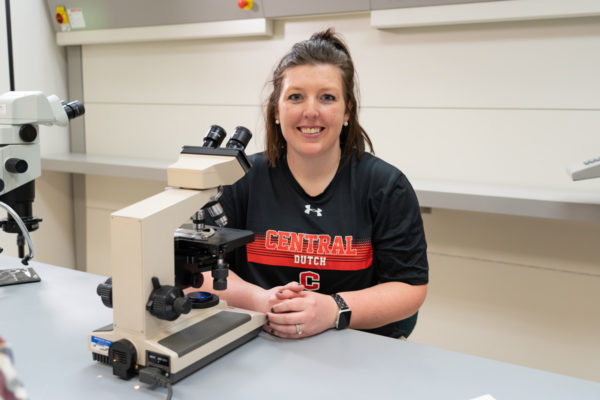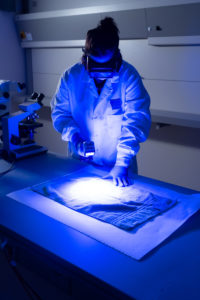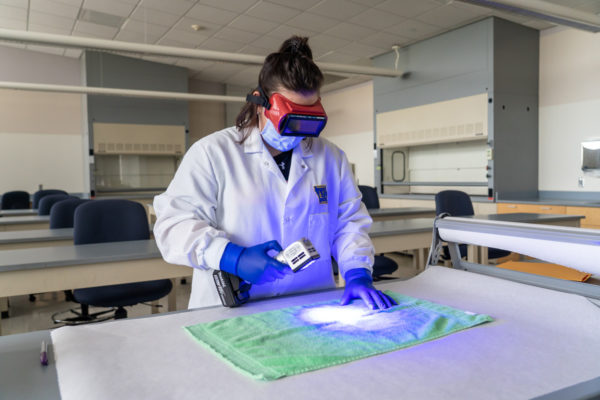I speak for the evidence,” says Karlee Rock Schneider ’15. She’s a criminalist for the Iowa Division of Criminal Investigation’s State Crime lab in Ankeny. As a forensic scientist, she applies scientific principles to test evidence in criminal cases — up to and including testifying to the existence and significance of that evidence in court.
“WE DON’T STRUT AROUND”
A spate of recent TV shows glamorized her career, but “we don’t strut around in high heels,” she says. “It’s a stressful job. Every day we encounter things that are not easy to deal with. If it comes into our lab, it’s because something bad happened. We see the results of murders, property crime and a lot of sexual assaults. We don’t judge innocence or guilt. We tell the court what the evidence tells us. Then it’s up to the judge or jury to decide.”
Growing up in Wheatland, Iowa, population 700, she was inspired to work in forensics after watching the TV show “Dr. G: Medical Examiner.” It features real cases of Dr. Jan Carla Garavaglia, chief medical examiner of Orange and Osceola counties in Florida. “I liked the connection between science and law: figuring out what happened to someone to bring the perpetrator to justice,” Schneider says.
SCREENING FOR BLOOD
Schneider suits up in her lab coat and snaps on her exam gloves and breathing mask with a dexterous nourish. She lays out her reagents, swabs and “evidence” on a lab table. (Everything is real but the evidence. It’s a genuine T-shirt with a veritable bloodstain on it, but one created specifically for training purposes. For confidentiality and to avoid evidence contamination, she can’t show the processing of material related to a crime.)
She’s incredibly focused and well organized — “Almost to the point of OCD,” she laughs — an advantage on a job that requires strict adherence to FBI-specified standards and attention to minute detail. But she also wanted a well-rounded life with time for sports and family, so spending a decade or so to become a medical examiner ultimately didn’t appeal to her. “Forensic science allows me to do similar kind of work without putting the rest of my life on hold,” she says.
She’s just completed a year of training at the Ankeny lab. Today, she’s going to run through the procedures she uses to gather and analyze DNA evidence. Such evidence can be present in bodily fluids or anything touched or worn by an individual, potentially indicating that individual’s presence at a crime scene.
DNA, she explains, has quickly become an incredibly powerful tool, and Schneider is excited to work with a forensic technique that brings to justice criminals who might have escaped prosecution not long ago.
“I’ve been taught by professors and colleagues who were here at the beginning of the forensic use of DNA,” she says. (The first DNA profile was created in 1984.) “It’s progressed a great deal, and I know I’ll see more development in the future.”
Before chemically testing the stained T-shirt, she checks for the potential presence of other bodily fluids. She straps on UV-filtering goggles that look a bit like a piece of welder’s gear to protect her eyes. Then she scans the T-shirt on the lab bench with a bright, UV-emitting light. It can cause seminal fluid, saliva and urine to fluoresce, appearing as a bright blotch. No blotch appears, so she snaps off the light and prepares to chemically test the stain for blood.
 ATTENDING CENTRAL
ATTENDING CENTRAL
Schneider is comfortable in a lab. She majored in biology and minored in chemistry at Central. She also spent a summer at Central on a lab research fellowship, studying the co-polymerization of lactide and CO2 with Assistant Professor of Chemistry James Dunne. She counts him as one of her favorite professors.
“He taught organic chemistry, which is not a fun class,” she says. “But I was never nervous asking questions. He’d explain things during the lecture, and if I didn’t get it, he’d explain it again to me in a different way until I understood. His door was always open; he was always willing to help.” She also worked on a research project with Dunne. “Unlike a typical instructional lab where we knew how the reactions would work, there wasn’t a known answer,” she says. “That enhanced my lab skills and forced me to step outside of my comfort zone.”
Another favorite was Ashley Garr, associate professor of chemistry. “She was my advisor. She knew what classes I had to take to qualify for graduate school and helped me fit them all in. She was always a friendly face and would help me out with any questions I had — even with classes I took from other professors if they happened to be unavailable for some reason.”
“The involvement of both of these professors was continuous, even after I was in graduate school and applying for jobs,” Schneider adds. “As you can imagine, the background checks for this kind of work are pretty thorough.”
Schneider also played four years of highly competitive Division III softball and studied abroad in London during her Central career. In fact, the ability to combine athletics, academics and extracurriculars was a huge draw for her when looking at colleges.
“The year I went to London, four other members of my softball team went abroad as well. That’s a big chunk of talent on a competitive team. None of my coaches batted an eye. They said, ‘Go for it! That’s what college is for!’ I don’t think that happens at every school.”
She gives a lot of credit to her coaches, including George Wares ’76, head women’s softball coach at Central. “I learned how to work under pressure, how to be consistent, how to think strategically, how to work with others to achieve a result even when the odds look long,” she says. “The experience was invaluable in preparing me for grad school and for this job.”
She calls her time in London “the most incredible three months of my life. I loved every second of it. It opened my eyes to the world. I hadn’t thought it would be possible with playing softball and getting a science degree, but it was and I’m so glad I did it.”
 TESTING THE EVIDENCE
TESTING THE EVIDENCE
Schneider checks her reagent chemicals to make sure they’re clean. She rubs the location of the stain with the swab. Then, using an eyedropper, she wets the top of a cotton swab with a reagent. The swab turns bright pink.
“Pink is more specific for blood,” she says. She wets another swab with a different reagent and swabs again. That one turns blue-green.
“Blue-green is more sensitive for blood,” she says. “When both swabs light up like that, I know it’s worth taking a DNA sample.” She snips off a sample of the stained section of T-shirt and places it in a tube, drops the remaining fabric scrap back in the evidence bag in which it was submitted to the lab and seals it with official evidence tape — complete with DCI insignia, her initials and the date. “Now we process the evidence,” she says.
A LAB TOUR
On the way to the DNA processing section, she gives a quick tour of the other sections, or divisions, which make up the crime lab:

TRACE EVIDENCE, ARSON AND EXPLOSIVES
Here, evidence is checked for accelerants used in arson, trace materials or bomb debris at crime scenes or on evidence that can link particular elements or perpetrators to a crime.
LATENT PRINTS
Criminalists do various kinds of chemical and optical enhancements here to visualize fingerprints on evidence and check them against a national fingerprint database. The same section also can analyze footprints and tire tracks.
QUESTIONED DOCUMENTS
Analysts in this section study handwriting samples, forged signatures and the impressions of computer printers and typewriters in an attempt to establish the identities of the people or machines that created them.
BREATH ALCOHOL
Technicians here calibrate, test and maintain alcohol devices used by all agencies in the state to detect blood alcohol concentration levels in drivers suspected of operating under the influence.
TOXICOLOGY
The presence of drugs or medications in bodily fluids is analyzed here.
DRUGS
This is where the actual suspect substance — white powder or green, leafy material, for example — is analyzed to determine its identity and/or purity.
FIREARMS AND TOOL MARKS
Criminalists here use a shooting range, archive of approximately 4,500 weapons and a variety of equipment to attempt to identify weapons used in crimes. This may include matching land and groove rifling impressions on bullets to specific firearms and identifying firing pin impressions on cartridges that can possibly show which weapon shot which bullet. This section also can match the impressions of other tools used by criminals, such as pry bars and bolt cutters, with the tool that made them using a two-stage, comparison microscope.
PHOTOGRAPHY
This section processes crime scene images taken in the field and photographic evidence brought to the lab.
EVIDENCE ROOM
Here’s where evidence involved in criminal investigations is delivered, logged and stored before and after analysis. There’s also a garage that houses the lab’s two crime scene trucks — mobile labs that travel statewide to collect and document evidence.
PROFILING CONVICTED OFFENDERS
Cheek swabs of anyone in Iowa convicted of a felony, sex crime or almost all aggravated misdemeanors are sent here to be processed into DNA profiles and stored in a database to help link multiple crimes or convict re-offenders. DNA. This section, where Schneider works, processes and analyzes DNA evidence.
GRAD SCHOOL
The distance from Central’s campus to the Ankeny crime lab is only about 50 miles. But Schneider’s route involved a 1,400-mile detour through Huntington, West Virginia. She applied to three top forensic science master’s degree programs — Syracuse University, Boston University and Marshall University. Marshall, in Huntington, was her top choice and the first to accept her; by the time Syracuse and Boston called, she’d already made her decision.
Marshall teaches a broad curriculum that prepares its candidates to go into any aspect of forensic science. To Schneider, the courses sounded intimidating.
“I thought I’d be studying day and night, stressed out,” she remembers.
Not so. “It was challenging, but I was well prepared to apply the science I’d learned at Central to forensics,” she says. “As well prepared, in fact, as some classmates who’d gone to schools with forensic science undergraduate programs.”
While in graduate school, Schneider interned one summer at the DCI lab in Ankeny in the firearms section. She liked what she saw. “There are 50 to 60 people working here, and it’s pretty close-knit. The people are great and the environment seemed collaborative.” She stayed in touch with the lab after graduating from Marshall and when a job came up in the DNA section, she jumped on it.

Karlee Rock Schneider ’15 says, “I’ve been taught by professors and colleagues who were here from the beginning of the forensic use of DNA.”
PROCESSING DNA
Now she’s been here more than a year and clearly knows her way around. Back in the lab, she entered a room of DNA extraction instruments. Each was named by the lab staff for a character in “The Big Bang Theory,” a recent popular sitcom featuring a group of young scientists.
As she loads the sample into an instrument dubbed Professor Proton, she explains the four stages of DNA processing: extraction, where she’ll separate DNA from other cellular material; quantitation, where she’ll determine how much DNA evidence is present; amplification, where she’ll make enough copies of the DNA — neither too many nor too few — for accurate analysis; and capillary electrophoresis, where she’ll capture the DNA using a laser and software.
The result is a graph, called an electropherogram, that’s somewhat akin to a genetic fingerprint. But, like a fingerprint gathered from a crime scene versus a fingerprint made on clean paper by inked skin, the data often requires interpretation: some DNA electropherograms have missing or weak information. Some samples contain the DNA of several donors and untangling them can be less than straightforward.
“Say it’s a sexual assault. Or there are two people bleeding on the floor,” says Schneider. “We attempt to separate the contributors out. The software can’t do that.”
It helps, she says, if they have “knowns” for comparison: clean, single-source DNA samples taken separately from a victim and a suspect, for example.
Sometimes the profile is too complex — there are too many donors or the signatures are too weak to use, and the evidence is inconclusive. In other cases, the evidence can be decisive. Either way, “we’re dealing with people’s lives. This is very important and sensitive information,” Schneider says. “We need to be objective. Everything is looked at by a second set of eyes. We have co-workers, supervisors and technical leaders. If you’re doing a hard case, you’re not doing it alone. It’s challenging work, but we have a lot of people who can help us.”
In that way, Schneider says, it’s not so different from her student days at Central when she had professors, coaches, classmates and teammates to turn to.
“I transformed during my time at Central,” she says. “All my experiences there developed my confidence and my independence and my determination to reach my goal. I’ve become a person I’m proud of.”
She reflects a bit. “You can have a lot of impact in this field. It’s a collaborative effort to solve a crime: It’s the agents knocking on doors, it’s the people in the field collecting evidence, it’s the detectives, lab personnel and others. But DNA can be a big piece of the puzzle. I’m doing just what I want to do.”
“I TRANSFORMED DURING MY TIME AT CENTRAL.”
– Karlee Rock Schneider ’15
A BOOMERANG ALUM
In fact, there’s a great deal of her life that flows from her time at Central. She and her husband Andrew Schneider, Pella news director and sports announcer for KNIA/KRLS Radio, live in Pella. So does her brother Kirby Rock ’12, a route salesman for Mahaska Bottling, and his wife Abigail Sparks Rock ’12, a senior financial analyst at Precision, Inc. After sending Karlee and her brother to school here, her parents moved to Pella also.
“Pella is great,” Schneider says. “I love Tulip Time, the bakeries, the meat markets — it’s almost like a big city in a small town. The community really rallies around high school activities and the college’s arts and athletics programs. I can see myself raising a family and sending my kids to school there,” she says.
“And the other day I saw Nicole Palenske, associate professor of biology, at the store. I only had one course with her, but she remembered me and asked how I was doing. That’s what I remember from visiting Central when I was looking at colleges. Everyone seemed so friendly and genuine. And they really are.”












To encourage serious, intellectual discourse on Civitas, please include your first and last name when commenting. Anonymous comments will be removed.
Ailton Do Nascimento
|
12:22 pm on December 19, 2019
Ola boa tarde .